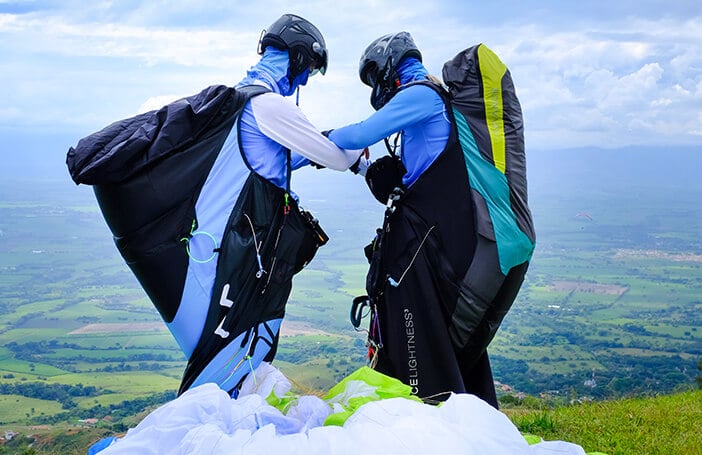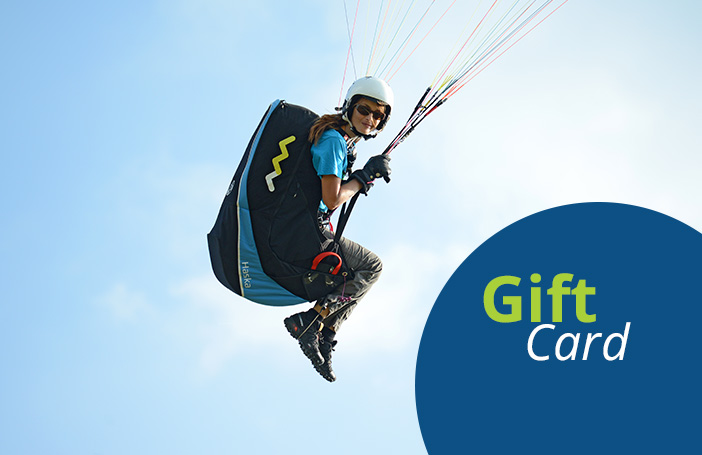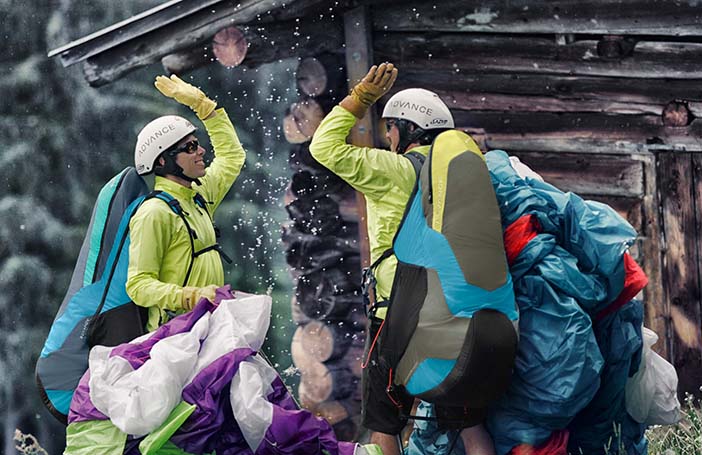
Ozone XXLite (PAST MODEL)
Select all options to view stock availability

This model is now discontinued. See the latest wings.
The revolutionary modern single surface wing for specialist climb & fly pilots.
The XXLite is one of the most unique paragliders to ever be put into production. This modern single-surface design is the absolute ultimate in ultra-lightweight flight and is probably the lightest aircraft in existence. The Ozone R&D Team contains several members who are avid alpinists and hike & fly pilots, and this wing is the result of our passion for innovation and adventure. It is a special wing for special pilots who fully understand its limitations, and have the skill and experience to pilot it.
With the entire canopy open to the relative airflow and approximately 5kg of air missing from “inside” the wing, the XXLite is more than 80% lighter while flying than a normal paraglider of the same size. This means that the pilot will experience more of the air than ever thought possible, as it has so much less inertia as it moves through variations in the air mass. This heightened “sensitivity” should not be understated, and it is important that pilots who choose to fly the XXLite are capable of appreciating the feedback that this wing will provide, and also of evaluating the conditions that are appropriate for flying it.
For the reasons above, it would be an oversimplification to call the XXLite a “descent” wing. The feeling of the XXLite in flight is totally unfiltered and may be disconcerting to pilots without the necessary experience. When flying the XXLite, it is important to realize that its movements and feedback are a natural result of physics. Without the weight of a volume of air inside the wing, the airfoil is highly affected by every movement it encounters in the atmosphere but this does not make the wing inherently unstable. Due to the wing’s lack of inertia, it also has far less of a tendency to overshoot, and this reduced amplitude is a positive characteristic in turbulence.
The pure glide performance of the XXLite is comparable to an Ultralite of the same size, but the trim speed is significantly slower and it does not have an accelerator system. Therefore, pilots must anticipate this lack of available speed when choosing conditions to fly in. The slower trim speed means that you will spend more time in a headwind or turbulent area, and your glide will be proportionately affected.
Despite its limitations, the XXLite can be a versatile wing and is capable of great things. During its air-trial period, Ozone Team Pilot Martin Bonis flew the XXLite to the summit of Mt Blanc, where he top-landed on one of the strongest thermal days of 2012. Likewise, pilots who enjoy the enhanced sensations of “unprotected sex flight” will get the most out of this exciting new design.
The XXLite is recommended for experienced pilots who are looking to add a special second (or third) wing to their quiver. As always, we recommend contacting your local Ozone dealer to arrange a test flight. If you think that the XXLite is right for you, then we hope that you enjoy flying this special project as much as we have, and we hope to share a summit with you one day.
SIZES
| 16 | 19 | |
|---|---|---|
| Number of panels | 41 | 41 |
| Projected area (m2) | 13.9 | 16.4 |
| Flat area (m2) | 16 | 18.9 |
| Projected span (m) | 7.4 | 8.1 |
| Flat span (m) | 9.3 | 10.1 |
| Projected Aspect Ratio | 4.0 | 4.0 |
| Flat aspect ratio | 5.4 | 5.4 |
| Root Chord (m) | 2.2 | 2.4 |
| Glider Weight* (kg) | 1.20 | 1.37 |
| In-flight weight range (kg) | 65-95 | 85-115 |
| EN / LTF | EN Load Test | EN Load Test |
* Weights may vary up to 50gm per size due to slight variations in the manufacturing of the fabric used.
MATERIALS
- Top Surface Cloth: Porcher 7000 E71A
- Rib cloth: Porcher 7000 E29
- Upper lines: Edelrid 8000U-050
- Mid lines: Edelrid 8000U-190/130
- Lower Lines: Edelrid 8000U-230/190
COLOURS
- Red-Orange-White (ROW)
- White-Orange-Light Blue (WOL)
TEST PILOT NOTES
The XXLite was tested intensively throughout its long development and has proved to be a stable and forgiving wing that can be safely flown in sensible conditions. Due to the wing’s extremely low weight and lack of internal pressure, the feeling of the XXLite in the air is quite unique, and the wing is unsuitable for inexperienced or nervous pilots. It is EN load tested to 8G at a maximum weight of 115kgs, but has no flight certification. What follows is a description of the XXLite’s behaviour.
- Inflation in zero to lights winds is extremely quick and easy, the wing stays easily overhead in just a light wind and is very straightforward to control.
- Launch behaviour in stronger winds is more demanding as the wing has a tendency to want to fly, it is best to control the wall with the rear risers.
- The take off lifting speed is relatively slow. Launching is straightforward and easy and as you leave the ground sooner than on a similar sized double surface wing.
- In the air, the brake pressure is light and progressive and the wing is very sensitive to inputs.
- Handling is direct and immediate so the thermalling behaviour and general manoeuvrability is very good.
- Feedback is unfiltered, it is very sensitive to the movements of the air, the wing transmits this with small movements in pitch and yaw. In stronger turbulence these movements can be quite fast, but are without much amplitude.
- It is best to fly with a small amount of brake applied at all times.
- Landing is straightforward but without the flare of a normal double surfaced wing.
EN FRONTAL COLLAPSE
The XXLite is very collapse resistant. Collapses normally occur progressively, starting with a deformation in the front part of the chord, which works its way rearwards.
Since the rear part of the chord generates a lot of lift, the reopening is spontaneous and immediate. There is no delay or tendency to stick.
Post collapse, no input is necessary for re-inflation - it will happen spontaneously. However, as with any front collapse on any wing, we recommend a symmetric input to aid reopening and to keep in contact with the trailing edge.
EN ASYMMETRIC COLLAPSE, 70-75%
The wing behaves in a similar way to the front collapse; it tends to deform more than collapse and the re-inflation is immediate.
Due to the small size and high wing loading, after an induced collapse the wing starts to rotate and dive with a fast movement, however due to the fast reopening behaviour, the pitch is generally no further than 45-60 degrees and the rotation no more than 90 to 135 degrees (without pilot input).
SPIRAL DIVE
The wing resists acceleration into deep spiral, with the “naked” ribs acting like an anti-spiral system and forcing the wing to stop as soon as the inside brake is released. The deceleration is immediate and the recovery to a straight flight very quick, faster than normal double surface wings.
SPIN / STALL TENDENCY
The brake range is long, and the brake pressure increases in a progressive manner and shows the same behaviour symmetrically (Flare/Full Stall entrance) and asymmetrically (Spin point). The pressure near the stall point is relatively high, and needs to be forced through this point to actually stall the wing.
The wing has no delay of recovery from an incipient stall, it will fly immediately with a positive movement forward. This movement is fast but with a low pitch angle.
FULL STALL
The Full Stall is a more demanding manoeuvre both technically and physically.
Due to the long brake range, the point of full stall requires a very deep brake input, taking wraps may be necessary.
The point of stall is quite sudden, the wing tends to drop back fast.
During the full stall, the brakes need to be kept low to counter the tendency of the wing to want to re-fly. This is more demanding than with most other wings.
The exit also requires attention; due to the small size of the wing, the sink rate during the full stall is high and therefore the brakes need to be released in a very slow and progressive motion.
The wing will recover flying with your hands still in a low position.
Upon exit of the Full Stall the pitch angle can be quite high, up to 90 degrees, so this needs to be countered.
CONCLUSION
Despite its good behaviour, we still feel that the XXLite is only suitable for experienced pilots and that it should only be flown in reasonably light wind and turbulence-free conditions.
SPECIAL NOTE
Compared with a normal paraglider, where the ribs are protected within cell walls, the exposed nature of the XXLite’s make it more susceptible to damage. Because of this extra care should be taken when handling the wing on take off, in the air and after landing. We do not recommend you to perform SIV or aerobatic manoeuvres. Doing so will reduce the lifespan of the wing and done incorrectly could result in damage to the wing.
CHOOSING YOUR SIZE
Do not use normal double surface wings as your reference, the XXLite is a unique wing and requires specific loading for optimum performance.
The wing creates lift at a relatively slow speed, so launching is straight forward, even when heavily loaded on the smallest size. The launch speed is similar to a double surfaced wing 3-4m bigger.
Speed is related to wing loading, it is important to not be below the recommended minimum weight range.
Pilots with an all up weight (remember the low weight of the wing) of 65-95 kgs should consider the 16, those between 85 and 115kgs the 19.
PACKAGE CONTENTS
Your Ozone wing is delivered standard with the following accessories: Specially designed 26lt or 33lt backpack, Inner Bag, Glider Strap, Ozone Stickers, Repair Cloth, Ozone Keyring, Line Length Chart.
You may choose to add something to your order, such as: Saucisse Bag (concertina packing bag), Easy Bag (quick stuff sack), or Ozone Clothing and Accessories.
| Condition | New |
|---|---|
| EN Certification | EN 926-1 Load Test |
| Model Status | Past model |
Standard UK delivery - £3.95 / FREE on orders over £100.
Outside the UK - delivery calculated at checkout (based on the total order value and your delivery address).
We use Royal Mail, Parcelforce Worldwide and other courier companies (e.g. DHL, DPD) depending on shipment value, weight, destination etc.
For more information, please view our order and delivery FAQs page.
If you are not 100% satisfied with your order, you have 14 days from the day of delivery to request a refund.
Delivery costs will not be refunded and you will be responsible for the delivery cost to return the order.
For more information, please read our returns and exchanges policy.



